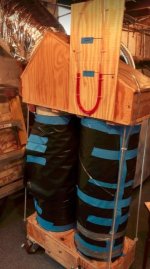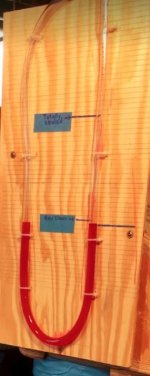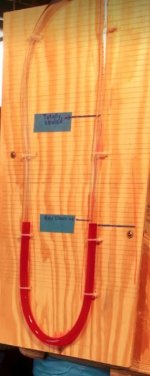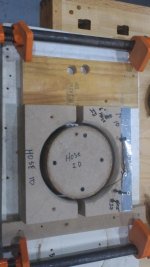egbell,
I have not seen the YouTube video to which you referred but it may be similar to the method I used to stretch the inside diameter (ID) of the pipe.
The setup I used to stretch the ID of the PVC pipe began by making a disk (die) whose diameter matched the ID sought. However, I allowed for a “loose fit" by adding 3/8” to the diameter of the stretching disk.
If I recall correctly I used the Milwaukee 6-3/8 in. Recessed Light Hole Saw to cut the three ¾”thick pieces of MDF stretching disks (
https://www.homedepot.com/p/Milwauk...{brand}+light+{product}+6"+install+kit+{rest}+). The three disks were then face-glued and screwed together, using the center hole for alignment.
The outer edge of disk (that would contact the pipe) was sanded smooth and edge along one face was chamfered with a rasp. The chamfer made slipping the heated and softened PVC easier over the disk. Two coats of furniture paste wax were applied the edge of the die to make releasing the PVC pipe easier, although I am not sure it helped. I applied fresh wax each time the die was used.
When the pipe cooled, I found removing the die was challenging. The method I used was to strike a 1” x ¾” stick resting on the die with a hammer several times along the inside wall of the pipe to pop the disk out. Also the die was attached to a ¾” plywood backer board. The backer board was large enough so that I could stand on the backer board, making starting the pipe over the die a bit easier; the die remained flat and could not rotate.
I made a couple of quick disconnects by stretching the ID of one end of a pipe while reducing the OD at the opposite end of the same length of pipe. The end of a short piece of PVC (about 8” long) was stretched so it could slip over unmodified PVC pipe. The opposite end of the short piece of pipe’s OD was reduced to accept 6” flex hose. The flex hose was attached one end of the short pipe and the opposite (stretched) end slipped onto the permanently mounted piping.
1) Was there any deformity at the gaps between the two halves of the die? I did not experience deformity of the pipe where the two halves meet. After sufficient heating with a heat gun, the PVC was soft and pliable but remained rigid enough to prevent deformation.
When I tightened the clamps to bring the two halves together, the clamping pressure was kept equal; one clamp was tightened half a turn then the opposite side clamp was tightened half a turn and so on. Since the pipe can cool quickly, I tried to bring the two halves together as quickly as possible.
I noticed that as the two halves were clamped together and began squeezing the pipe, they would lift. The lifting problem was solved by screwing one half to a ¾” plywood backer. C clamps were used to keep the unattached half down and flat on the backer board. The backer board was elevated off the floor using a pair of 2 x 4 scraps set on edge.
The inner disk was a subsequent modification. Before the modification, the interior of the pipe deformed as the pipe was squeezed to achieve the smaller outside diameter. The inner disk solved this problem. Chamfering was not necessary on the inner disk since it is smaller than the nominal ID of PVC pipe.
2) You have the inner disk labelled Hose ID. Is that actually less than the hose ID? Yes, but irrelevant in my application. The contraption shown in post # 176 was used to reduce the outside diameter of the 6” SRD-35 pipe so that 6” flex hose would slip over the end of the pipe. That is the new (shrunken) outside diameter of the PVC pipe was such that the flex hose fit over the outside of the pipe. This allowed a hose clamp to be used to keep the flex hose affixed to the outside of the PVC pipe.
This method does produce a lip at the flex- hose – PVC pipe junction where turbulence could affect air flow. One additional step to reduce this turbulence would be to taper the inside edge of the shrunken pipe with a rasp. I do not recall performing this additional step.
The diameter of inner disk was the diameter of the outer two-part ring MINUS 2 times the thickness of the PVC. While I do not specifically recall, I probably further reduced the diameter of the inner disk by 1/8” to ¼”. This further reduction made fitting the flex hose over the pipe a bit easier.
The disk used to shrinking the OD of the pipe was label “ID” to keep from mistakenly using this disk when I wanted to stretch PVC pipe. This is the kind of mistake I could easily make and since it could mean re-heating a pipe, I decided the avoid confusion by adding the label.






